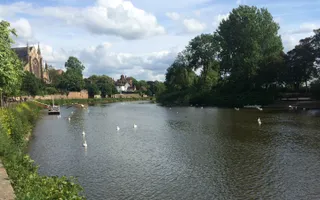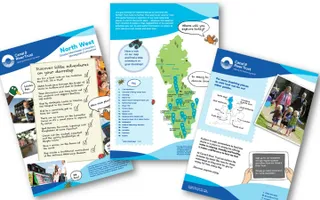The River Severn is the UK's longest river. It runs for 220 miles from the Welsh mountains, through the beautiful Shropshire and Worcestershire countryside and down to the flatlands of the Severn estuary.
The Severn truly has something for everyone: historic cities, delightful scenery, cosy pubs, stunning cathedrals and boats of just about every shape and size. It is famous for its tidal bore, the second highest tide anywhere in the world. At very high tides, water is forced from the wide estuary into the narrower channel upstream. This forms a wave (or bore) that travels inland as far as Gloucester and beyond.
Thanks to the Severn Way, a continuous towpath along the Severn, you can explore the whole length of the river on foot from source to sea. It's quite a stroll!
Boating on the Severn Navigation
The section from Gloucester to Sharpness is dangerous for boats, and is bypassed by the Gloucester & Sharpness Canal. The section below Sharpness is not recommended for inland craft, unless they are equipped for a short sea voyage and have experienced crews, or else with the help of a licensed River Severn pilot.
The history of the Severn Navigation
Since records began the Severn was a ‘free river', meaning that navigation was free of charge. Below Gloucester the navigation was estuarial, and boating was helped by the fortnightly spring tides as far as Upton. Boats of 60 tons could reach the Ironbridge Gorge, and of 40 tons to Shrewsbury. In good conditions smaller boats could get up the river as far as Pool Quay, near Welshpool.
Traffic peaked in the mid-18th century, with some 100,000 tons of coal a year coming down from the collieries round Madeley and Broseley to the saltworks at Droitwich and the various riverside towns. Other significant traffic was pig iron from the Forest of Dean and the Ironbridge Gorge, salt from Droitwich, timber coming downriver and the goods needed by the towns going upriver.
It was not an easy river to navigate
Water flows could be too high, especially in the springtime, or too low in times of drought, a problem made worse when banks were made to protect farmland from flooding. Shoals impeded boats in several places, especially in the Gorge. Towing was by teams of men. There was no towpath suitable for horses until 1800 between Bewdley and Ironbridge, and a dozen years later for the full length between Gloucester and Shrewsbury.
Traffic on the river increased when canals from the Midlands opened: the Staffordshire & Worcestershire Canal in 1771 and the Worcester & Birmingham Canal in 1815.
It was not until the 1843–5 that any locks were built on the Severn, when the Severn Commission constructed four from Diglis Lock, just below Worcester, to Bevere Lock, below Stourport. Upper Lode Lock, below Tewkesbury, was added in 1858.
Although traffic on the river above Stourport had stopped by 1900, steam-powered boats and tugs provided an effective service on the lower part of the river. Grain imported through Sharpness became an important traffic, other significant traffics being imported ironstone and timber, and coal from the Forest of Dean. In the 20th Century oil and petrol became a major traffic, but this largely ceased in the 1960s.
The Severn today
The different sections of the River Severn are very different in character, offering something for everyone. We look after the River Severn from Stourport to Gloucester, a section which is ideal for pleasure-boating busy with narrowboats, motor cruisers and inland waterway boats. Above Stourport, canoes and rowing boats take over.
The Severn offers a host of destinations for day trippers
First and foremost, our own National Waterways Museum, Gloucester promises family fun and boats galore. History buffs should also visit Ironbridge Gorge, the cradle of the Industrial Revolution. There's the magnificent cathedral at Worcester, historic docks at Gloucester, rowing boats and relaxation at Stourport and a pleasing selection of music festivals at Upton-on-Severn. Not forgetting the beautiful countryside which is some of the best that Britain has to offer.
Feeding the ducks or just watching the boats is a great way to spend time by the water with your youngsters. Best of all, a trip to one of our canals or rivers doesn't have to cost you a penny.
Download free activity guides to the River Severn













